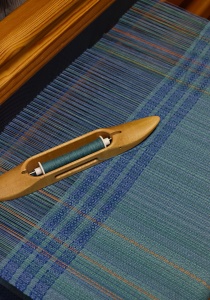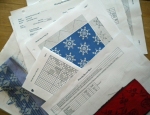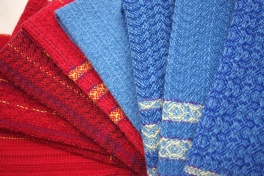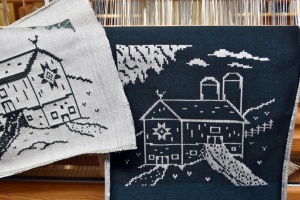“What does this loom do that your other loom doesn’t?”
That’s the question my sister asked me when I told her last year that I was thinking about getting another big loom. It’s a reasonable question. A loom is a big expense. It takes up a lot of space. There’s only one of me and I can only weave on one loom at a time. So why get another one?
There’s no short answer, really. Weaving is just making threads go up or down to produce fabric. This can be done with your fingers, on frames, with back straps, even pieces of cardboard with slits cut in it. How many of us, as kids, wove those ubiquitous little pot holders with knit loopers on metal frames?
Looms are tools. Weavers use them to create the fabric that is in their heads. The real question is what do we want to weave? That determines the loom.

Schacht Baby Wolf jack loom
Most weavers learn on jack looms. When you step on a treadle, the shafts connected to it are jacked up, the others stay down. That’s how the shed is made. Each treadle controls any number of shafts, making design possible. My first loom was a four-shaft Harrisville jack loom, 22” weaving width, a good starter loom.

Counterbalance Union rug loom
Many old rug looms and barn looms are counterbalance looms. Each shaft is tied to an opposing shaft so that when the treadle tied to the first shaft is depressed, that shaft goes down and the opposing shaft goes up. My grandmother’s old Union loom was a 2-shaft counterbalance loom.
Many Swedish looms are either counterbalance or countermarche. On countermarche looms, when a treadle is depressed, every shaft goes either up or down. Every shaft is tied to every treadle. This opens the shed in both directions, up and down, and is easier on the warp threads. It’s also easier to treadle designs with lots of heddles on individual shafts.

Countermarche tie-ups, every treadle on every shaft.
All these looms produce beautiful fabric: simple plain weave, twill, lace, overshot, blocks, units, diagonals, layers. The weaver is only limited by the number of shafts on the loom. Without going into a treatise on weaving theory (for which I am definitely unqualified!), I can say from experience that each type of loom has its design possibilities and limitations.*
When I bought my first big loom, my intention was to get the one loom that would do whatever I wanted to weave forever and ever, amen. But how was I to know what directions my weaving would take at this early point?
Besides my little Harrisville, I had woven on Glimäkra countermarche looms at a week-long class and really liked how sturdy they are, the overhead beater, the treadling action. During that week, I also wove samples on both a single-unit drawloom and a shaft drawloom. Drawlooms add a whole world of possibilities to weaving.
A drawloom has a set of shafts separate from the ground shafts. The shaft drawloom produces repeating designs across the warp. These can be symmetrical or mirrored, tiled or single figures. The single unit drawloom lets you lift individual units to produce asymmetrical non-repeating designs. After some careful thought, I chose a Glimäkra countermarche loom with a 20-shaft drawloom attachment to grow into.
But a couple years ago, I thought a second big loom would be very useful. The drawloom setup is different than the regular set-up and every time I needed to switch from one to the other, it took a day to change heddles and rebalance the loom. It would be more efficient if I could have one loom as my regular loom and one loom set always as a drawloom.
That was the short answer to my sister’s question—efficiency and productivity.
And now I am getting closer to that goal of a dedicated multi-shaft loom and a dedicated drawloom. This week I ought to take delivery on a combination shaft and single-unit drawloom. This set-up fits onto my second loom and will allow me to continue weaving the damask designs I’ve been doing, as well as adding single unit motifs. I’m thinking of flowers, birds, dragons, even words.
I can hardly wait to see what this new set-up will do. Always learning, always growing.
* For a thorough look at weaving theory, check out these books:
- Madelyn van der Hoogt’s The Complete Book of Drafting for Handweavers (1993, Shuttlecraft Books).
- Sara von Tresckow’s When a Single Harness Simply Isn’t Enough (2014, The Woolgatherers, Ltd.) describes in detail the workings of drawlooms.
- The Book of Looms by Eric Broudy (1979, University Press of New England) presents a good history of looms of all kinds from around the world.
 Near the end of a project, with the final throws of the shuttle, while I’m quietly stitching the hem, there’s a hint for the next warp. It teases its way into my brain. It’s the “what if…” that carries weavers to rethread the loom time and again.
Near the end of a project, with the final throws of the shuttle, while I’m quietly stitching the hem, there’s a hint for the next warp. It teases its way into my brain. It’s the “what if…” that carries weavers to rethread the loom time and again.























